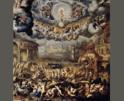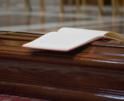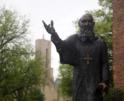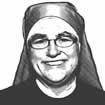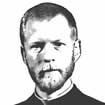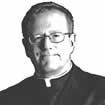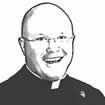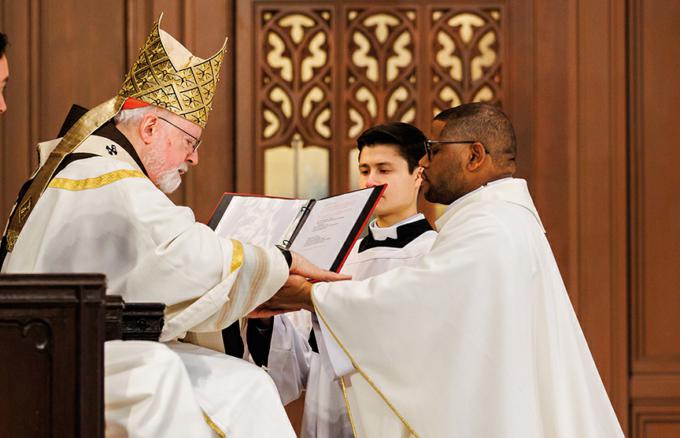
Faith
Within each of the rites for a particular order, there are some differences relative to the particular order.
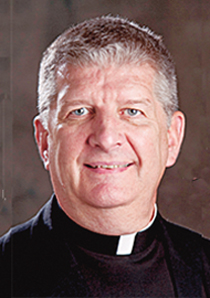
O’Grady
The very first new liturgical book issued following the call of the Second Vatican Council is what is today called Ordination of a Bishop, of Priests, and of Deacons. The Latin text was released by the Holy See on June 18, 1968. An interim English translation was completed relatively quickly. In fact, the second time the new "interim" rite for episcopal ordination was celebrated in the U.S. was in our archdiocese on Sept. 12 of that year, when Cardinal Richard Cushing ordained his new auxiliary Bishop Daniel A. Cronin at the Cathedral of the Holy Cross. The recently released English translation of the second version of the book with the above title will be used on Feb. 3, 2024, at our cathedral for the episcopal ordination of Bishop Cristiano G. Borro Barbosa. Cardinal O'Malley has already used the sections for the ordinations of priests and deacons and will use those again in the spring ordinations.
The council entrusted the reform of the ordination rites to the pope, Pope St. Paul VI, and in turn, he created a post-conciliar group of experts and consultors to assist him in this task. The pope took a keen interest in all phases of the liturgical reform. And the rite of episcopal ordination bears a personal imprint of this pope. He requested that the episcopal ordination rite begin with the chanting of the ancient hymn to the Holy Spirit -- "Veni creator spiritus."
There are three orders -- bishop, priest (or presbyters), and deacon.
Each ordination, which is always to be celebrated within Mass, follows a similar pattern. Here is a general outline.
Introductory Rites
Liturgy of the Word
-- Election
-- Homily
-- Promises
-- Litany of Supplication
-- Imposition of Hands
-- Prayer of Ordination
-- Explanatory rites
-- Vesting
-- Anointing
-- Presentation of Signs of Office
-- Fraternal Kiss of Peace
Liturgy of the Eucharist
Concluding Rites
Within each of the rites for a particular order, there are some differences relative to the particular order.
One example is the imposition of hands and prayer of ordination. For the ordination of a bishop, the principal ordaining bishops, the principal co-ordaining bishops, and all other bishops present impose hands, and they together recite a specified section of the prayer of ordination. For a priest, the ordaining bishop and all other priests (presbyters but not other bishops present) impose hands, the ordaining bishop alone proclaims the prayer of ordination. And for a deacon, the bishop alone imposes hands and he alone proclaims the ordination prayer. The imposition of hands is to be carried out in silence. The general introduction #7 gives this direction for this most important moment in each ordination: "While the laying on of hands is taking place, the faithful should pray silently. They take part in the Prayer of Ordination by listening to it and by affirming and concluding it through their final acclamation."
This is an excellent reminder to all of us that our liturgical participation can be through silence and through listening. Often, we think that participation means we must be acting or responding verbally or musically.
The book contains major revisions of the ordination rites, and so it begins with one of the most solemn forms of a papal document, an apostolic constitution. This one, titled "Pontificalis Romani recognition" ("The Revision of the Roman Pontifical"), contains in summary form the background and brief history of the rites, theological explanations, and some details about what is required for the proper celebration of the respective rites, and the reason for the new rites.
Each ordination rite has a more detailed theology of the respective order, as well instructions for the celebration of that order. These are called "praenotanda," translated as "introduction." Helpfully, each introduction also provides a list of those things that should be prepared in advance for the particular order (this presumes the preparation of all the requisites for Holy Mass) and the various ministries to be exercised for a particular ordination (again presuming all those for Mass).
Regular Pilot readers know that The Pilot covers all of the ordinations celebrated for the archdiocese, introducing you to the ones to be ordained prior to the ordination and following up with coverage of the ordinations themselves. The ordinations are available through The CatholicTV Network both with live coverage and through its archives.
The episcopal ordination of Bishop Cristiano G. Borro Barbosa will be broadcast by CatholicTV on Feb. 3, 2024, beginning at 10 a.m.
The Pilot is preparing a special issue for Feb. 2, with much more pre-ordination material, including a more detailed look at the episcopal ordination rite itself, as well as biographical information and an extensive interview with our new auxiliary bishop. Coverage of the ordination will be included in the Feb. 9 issue.
Recent articles in the Faith & Family section
-
Speak, Lord!Archbishop Richard G. Henning
-
Heads upScott Hahn
-
America, In the Power of the Spirit, Witnesses to ChristMaureen Crowley Heil
-
Liturgical music for funeral liturgiesRichard J. Clark
-
Scripture Reflection for Dec. 1, 2024, First Sunday in AdventFather Joshua J. Whitfield


